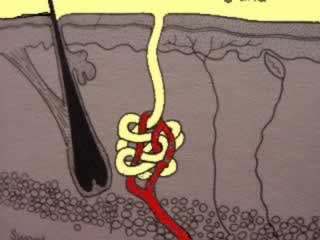|
Skin, oil and finger prints
|
|
|
|
Finger prints are formed by the oil that is present in our skin. The finger print patterns on our skin help us to better grip objects. The oil however, is important in two major ways. The first is that it waterproofs our skin. The second is that is flushes out bacteria lurking inside the hair follicle. This particular action of oil is very important and its failure only becomes obvious during puberty or when eating a high fat diet. During puberty many youngsters get pimples. Pimples are infections of the hair follicle. The oil (sebum) is too thick during puberty or during the ingestion of fatty foods to effectively flush out bacteria. Bacteria therefore thrive and multiply in the moist, warm environment of the hair follicle. |
| The skin surface is alive with many microorganisms living on the surface and deep inside its many grooves and openings. The surface of the skin is made up of dead cells which are constantly being replaced. Dead cells are always falling from our skin and it is almost impossible for burglars not to leave some kind of evidence of their presence. |  |
